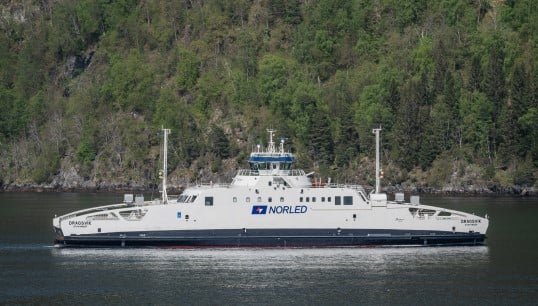- Topics
- Campaigning
- Careers
- Colleges
- Community
- Education and training
- Environment
- Equality
- Federation
- General secretary message
- Government
- Health and safety
- History
- Industrial
- International
- Law
- Members at work
- Nautilus news
- Nautilus partnerships
- Netherlands
- Open days
- Opinion
- Organising
- Podcasts from Nautilus
- Sponsored content
- Switzerland
- Technology
- Ukraine
- United Kingdom
- Welfare
Norway introduces zero-emissions requirement from 2026 to world heritage fjords
21 May 2025

Andrew Draper reports on the gradual imposition of new rules aimed at protecting the sensitive marine environment of Norway's fjords
The Norwegian Maritime Authority (NMA) has decided to introduce a zero-emissions requirement for vessels visiting its five world heritage fjords from next year. This is later than originally planned.
The tightening will affect ships operating with traditional fuels, while seafarers working on largely battery powered ships in the fjords are unlikely to be affected.
Hans Sande, Head of the Norwegian Maritime Officers’ Association (NMOA), told Nautilus International: 'It will have no consequence for our members. The ferry fleet in Norway is electrified. The environment in our fjords is also important for our members.'
The Norwegian fjords in western Norway which are recognised as UNESCO World Heritage Sites include Geirangerfjord, Nærøyfjord, Aurlandsfjord, Sunnylvsfjord and Tafjor.
The proposal, presented on 14 April by the NMA, will apply from 2026 to passenger vessels with capacity for over 12 people and under 10,000 GT. From 2032, the rules would apply to passenger ships of over 10,000 GT.
There have been various official moves to cut emissions of methane and CO2 in the fjords, which are visited by international cruise ships, including:
- The Norwegian parliament, the Storting, decided in 2018 there should be a zero-emissions requirement in the world heritage fjords by 2026.
- In 2021, the government proposed the establishment of shore power in Flåm, southwestern Norway, in the heart of the fjords.
- In 2023, the NMA proposed a key rule on zero emissions for tourist vessels and ferries and this became the subject of consultation following government involvement. It also envisaged a transitional arrangement where biogas and non-biological fuel would be allowed under certain conditions as an alternative to zero emissions
The NMA said battery power is a good alternative for vessels under 10,000 GT and that access to shore power is crucial to meeting the zero-emissions requirement. 'Use of hydrogen and ammonia technology as an alternative to conventional fuel is not accessible by smaller passenger vessels,' said the NMA.
Larger vessels can continue operating as now until 2032 and have more time to adjust to the net-zero emissions requirements, said the NMA. The phased approach recognises that the fuel technology for the largest ships is still being developed.
P&O Cruises, which operates cruises to Norway's fjords from Southampton, said it complies with all laws and regulations that govern its business, including any future changes enacted by the Norwegian Government.
A spokesperson said: 'We are determined to lead the way in the cruise industry by promoting positive climate action, contributing to a circular economy, partnering with the communities to which we sail and reducing our greenhouse gas footprint.
'We are the only major cruise company producing fewer greenhouse gas emissions today than we were in 2011 – despite increasing our capacity by roughly 30% in that time. We continue to make solid progress toward our ambition of achieving net carbon-neutral ship operations by 2050, investing in technologies and solutions to reduce our greenhouse gas footprint, including trialling maritime scale battery technology and methanol-powered fuel cells, piloting biofuel as a replacement for fossil fuel, and more.'
Tags
